Growing Sword Lilies With Fred Miller From The Empire State Gladiolus Society

BULBS > GLADIOLUS

Elizabeth is a Permaculture Garden Designer, Sustainability Consultant and Professional Writer, working as an advocate for positive change. She graduated from the University of St. Andrews with an MA in English and Philosophy and obtained a Diploma in Applied Permaculture Design from the Permaculture Association.
Reviewed By COLIN SKELLY

Colin is a Horticulturist and Horticultural Consultant with experience in a range of practical and managerial roles across heritage, commercial and public horticulture. He holds the Royal Horticultural Society’s Master of Horticulture award and has a particular interest in horticultural ecology and naturalistic planting for habitat and climate resilience.
Contributions From FRED MILLER

Fred Miller is a long-time member and Secretary of the Empire State Gladiolus Society with an affinity for gladioli and other bulbous plants.
IN THIS GUIDE
GLADIOLUS GUIDES
Container Growing
Growing From Seed
Overwintering
Planting
Pruning
Gladiolus bulbs are technically ‘corms’.
Gladioli are beautiful flowers, which can look great in your garden, whether you grow them in the ground or in pots.
In this article, you’ll learn when to plant the bulbs, how to plant them, and with what.
We even interviewed Fred Miller from the Empire State Gladiolus Society to provide additional insight.
“When planted deep enough, gladioli hold themselves upright and bloom as planned each season”, shares Fred, when asked why he is so passionate about these plants.
“The many colours and sizes make them the perfect cutting flower to be used on their own in a vase or in an arrangement with other flowers”.
Overview
| Botanical Name | Gladiolus |
| Common Name(s) | Sword Lilies |
| Plant Type | Bulbs / Perennials |
| Native Area | Asia, Mediterranean, Europe, South Africa & Tropical Africa |
| Hardiness Rating | Differs by variety |
| Foliage | Deciduous |
| Flowers | Various |
| Flowering Months | June, July |
Sunlight
Preferred
Full Sun
Exposure
Sheltered
Size
Height
0.5 – 1M
Spread
0 – 0.1M
Bloom Time
June – July
Soil
Preferred
Chalk, loam, sand
Moisture
Well-drained
pH
Any
Plants in this genus, in the Iris family, are sometimes called ‘Sword Lilies’ and the name comes from the diminutive form of the Latin for ‘sword’.1Origin and meaning of gladiolus. (n.d.). Etymonline. Retrieved March 16, 2023, from https://www.etymonline.com/word/gladiolus

There are around 300 different species of Gladioli native to Asia, Mediterranean Europe, South Africa and tropical regions of Africa.2The Editors of Encyclopaedia Britannica. (2023f, March 9). Gladiolus | Description, Species, & Facts. Encyclopedia Britannica. Retrieved March 16, 2023, from https://www.britannica.com/plant/Gladiolus
Many species have been used in hybridisation, and now there are many, many varieties out there for gardeners to choose from.3Chaudhary, V., Kumar, M., Sharma, S. K., Kumar, N., Kumar, V., Yadav, H. K., & Sirohi, U. (2018). Assessment of genetic diversity and population structure in gladiolus (Gladiolus hybridus Hort.) by ISSR markers. Physiology and Molecular Biology of Plants, 24(3), 493–501. https://doi.org/10.1007/s12298-018-0519-2
Today’s main hybrids used in horticulture have been obtained through the interbreeding of four or five different species.
Gladiolus have sword-like leaves, and tall flower spikes with funnel-shaped blooms in a huge range of colours.

They fell out of fashion for a time but are now making a resurgence.
“Gladiolus is definitely making a comeback,” shares Colin Skelly, Master Horticulturist.
“I like to grow some of the species, such as G. communis subsp. byzantina and G. murielae.
“These are not very tall, so tend to stay upright without support and the flowers are striking without being overly blousy.”
Why Grow Gladiolus?
Gladioli are sometimes thought of as quite fussy and stolid as a garden choice.

With a heavily floral scheme, they can sometimes create a rather old-fashioned appearance to a garden bed, border or pot.
However, alongside grasses and lighter perennial blooms, they can look great and bring good contrast to a design.
As well as looking good in beds, borders and containers, Gladioli also make very good cut flowers, to bring into your home.

The flowers can bloom between March and August, depending on when they were planted, and which variety or varieties you are growing.
You might be interested to hear that gladiolus flowers are also edible – you can use the mild-lettuce-like petals as you would use squash blossoms.4Daily home & garden tip: Fill edible gladiolus blossoms for a dramatic dish. (2011, April 30). The Oregon. Retrieved March 16, 2023, from https://www.oregonlive.com/homesandgardens/2011/04/daily_home_garden_tip_fill_edi.html
With some varieties, the corms also have culinary uses and are considered a delicacy.
Gladiolus Varieties
There are a huge range of Gladioli to consider growing in a UK garden.
“The many colours and sizes make them the perfect cutting flower to be used by themselves, or in an arrangement with other flowers,” argues Fred.

Some options to consider are:
- G. ‘Robinetta’ (recurvus hybrid) (AGM)
- G. communis subsp. byzantius (AGM)
- G. murielae (Abyssinian gladiolus) (AGM)
- G. italicus (Field gladiolus)
- G. papilio (butterfly sword gladiolus)
- G. cardinalis (waterfall gladiolus)
- G. tristis (evening flower)
- G. ‘Trader Horn’
- G. ‘Charming Beauty’
- G. ‘Belle de Nuit’
- G. ‘Vera Lynn’
- G. ‘The Bride’
- G. ‘Happy Weekend’
- G. nanus ‘Charm’
- G. ‘Miss Green’
Of course, these are just some of the many beautiful options that you could consider growing in your garden.
Where To Grow Gladiolus
It is important to remember that Gladioli come from hot and sunny places – so it is important to choose a location in your garden where they will be able to enjoy a sheltered spot, with as much sunshine as possible.
Gladiolus varieties can be grown in the ground in a sunny bed or border, or in a container, as long as moist yet free-draining conditions can be provided.
Fred Miller explains that one of the most important factors in growing gladioli is that you buy and plant good quality corms.
You can plant directly into the ground as long as there are fertile conditions and as long as the soil does not become waterlogged.
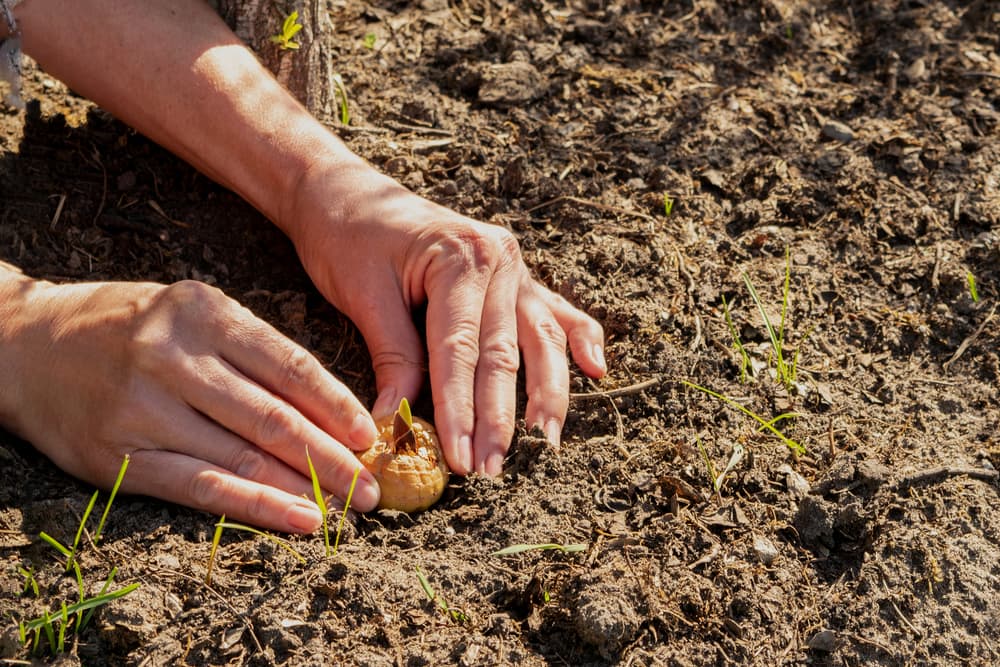
If growing in the ground, be sure to add plenty of organic matter such as compost or well-rotted manure.
In more northern parts of the UK, Gladioli are unlikely to overwinter successfully in the ground; it can be better to grow these in containers that can be moved undercover.
However, you can also grow them in a border in summer and mulch heavily for protection, or you can lift the corms for winter storage.
Gladiolus Companion Planting
Gladiolus do not bring any particular benefits for other plants growing close by.
But choosing the right companions for Gladioli can help you achieve an attractive display.

In larger containers, for example, or in a bed or border, you might pair a number of different Gladiolus varieties.
“We grow Dahlias,” says Fred.
“The best part about dahlias is as you cut them, more new blooms grow, and continue throughout the growing season. We enjoy arranging them in a vase with the gladiolus.”
Growing with zinnias might be another good option.
You might also create a dramatic border with Gladioli and Foxtail lilies, or with Alliums, Verbena bonariensis and grasses for a lighter look.
Gladiolus Care
Gladiolus are not particularly difficult to care for if you grow them in the right spot.
Giving them full sun and plenty of water are said to be the two most important factors for these plants.
However, there are a number of other things that you have to get right to grow them successfully.
Support
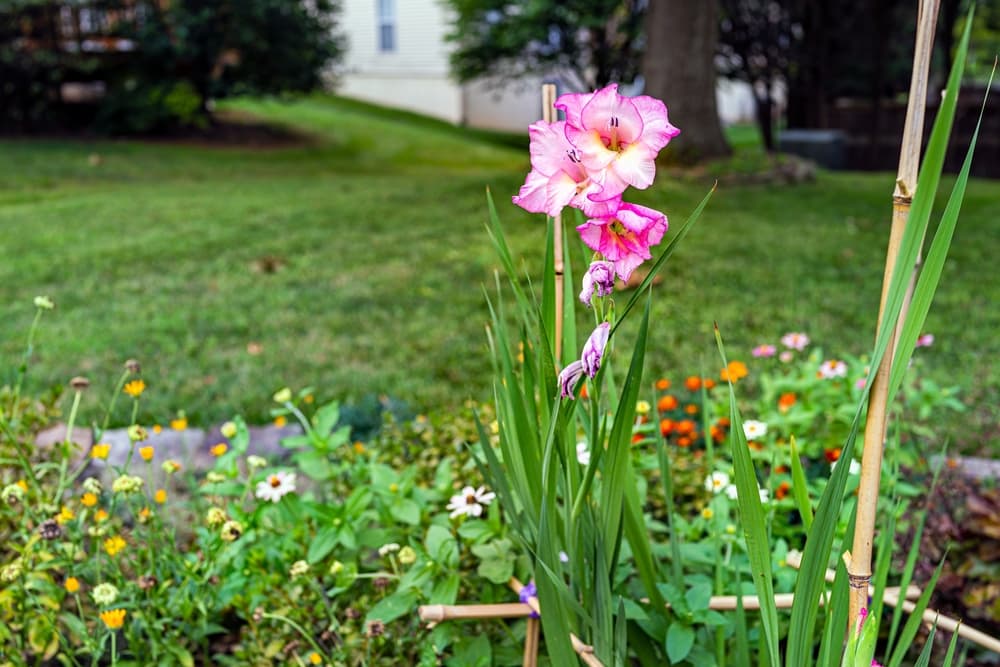
One thing to think about is that most Gladiolus varieties will need some form of support.
Usually, the plants will have to be staked before the flower spike emerges.
Remember, you do not necessarily have to buy in your plant supports – you may be able to make use of branches or bamboo canes grown elsewhere in your garden.
You should tie in your plants to your stakes to make sure that they do not flop over or become damaged as they grow.
Watering
Make sure that you water well during the growing season, especially when growing gladioli in containers.
Just make sure that the water can drain freely, and the soil or growing medium is kept consistently moist, but not damp and waterlogged.
Feeding
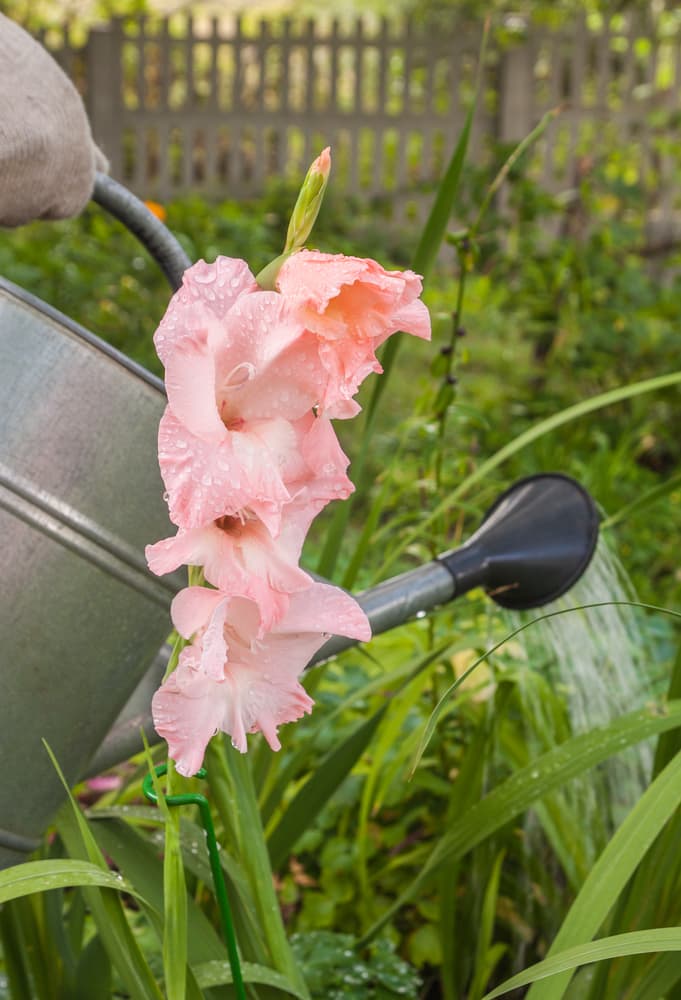
For best results, feed your gladioli with an organic liquid feed while it is in flower.
An organic feed suited to tomatoes will work well for gladioli too. For example, you might use a liquid feed made from comfrey for the purpose.
This potassium-rich feed should encourage healthy and beautiful flowers.
Common Problems
Gladioli can be bothered by slugs, and also by sap-suckers like thrips and aphids.
“Watch for thrips (and other pests) and be sure to keep them away from your plants”, says Fred.
Taking care of wildlife in your organic garden, and boosting biodiversity can help keep pest populations under control.
Make sure you attract slug-eating creatures, and predatory insects like ladybirds and lacewings to your garden to reduce the chances of these problems occurring.
You should also remain vigilant, and remove affected foliage and blooms quickly when you spot an insect infestation.
To avoid problems Fred Miller suggests that once the plant is done blooming, or cut, you should let the leaves grow for 6 weeks before you harvest the corms for the next growing season.
Diseases
Gladioli can be affected by a range of plant diseases including Botrytis Blight, Leafspot, Scab and more.5Gladiolus Diseases. (n.d.). Penn State Extension. Retrieved March 16, 2023, from https://extension.psu.edu/gladiolus-diseases
Keeping corms healthy to avoid introducing these problems is an essential requirement for anyone growing these plants, insists Fred.
“Most of us here in Central New York, USA are careful not to compost old mother corms or stalks. We either burn them or throw them out,” he says.
Division
Every few years, in autumn, it is best to divide mature Gladioli clumps.
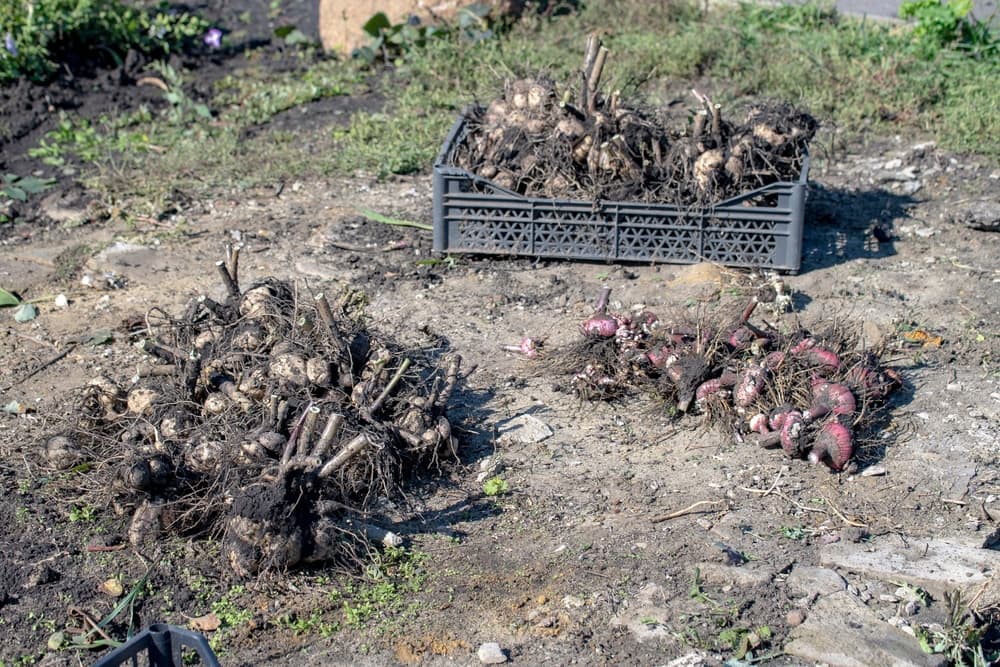
There are two main reasons for this –
- Avoiding congestion – when gladioli clumps become congested, the plants will be weaker, and flowering may reduce considerably. The plants may even stop flowering altogether.
- Propagating new plants – corms can be split from the clump to create new plants for a different container, or a different part of your garden.
Gladiolus bulbs, or corms, can provide you with colour and interest in your garden over a number of years to come, as long as you place them in the right places and care for them correctly.
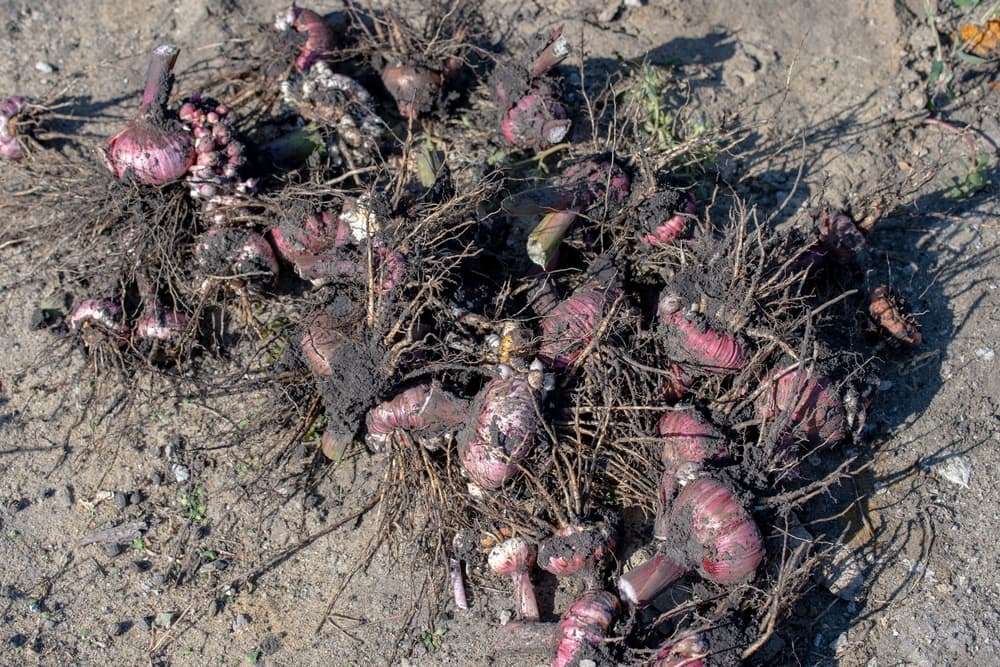
All said, Gladioli can be a great choice for a long-lasting, beautiful garden.
References
- 1Origin and meaning of gladiolus. (n.d.). Etymonline. Retrieved March 16, 2023, from https://www.etymonline.com/word/gladiolus
- 2The Editors of Encyclopaedia Britannica. (2023f, March 9). Gladiolus | Description, Species, & Facts. Encyclopedia Britannica. Retrieved March 16, 2023, from https://www.britannica.com/plant/Gladiolus
- 3Chaudhary, V., Kumar, M., Sharma, S. K., Kumar, N., Kumar, V., Yadav, H. K., & Sirohi, U. (2018). Assessment of genetic diversity and population structure in gladiolus (Gladiolus hybridus Hort.) by ISSR markers. Physiology and Molecular Biology of Plants, 24(3), 493–501. https://doi.org/10.1007/s12298-018-0519-2
- 4Daily home & garden tip: Fill edible gladiolus blossoms for a dramatic dish. (2011, April 30). The Oregon. Retrieved March 16, 2023, from https://www.oregonlive.com/homesandgardens/2011/04/daily_home_garden_tip_fill_edi.html
- 5Gladiolus Diseases. (n.d.). Penn State Extension. Retrieved March 16, 2023, from https://extension.psu.edu/gladiolus-diseases
